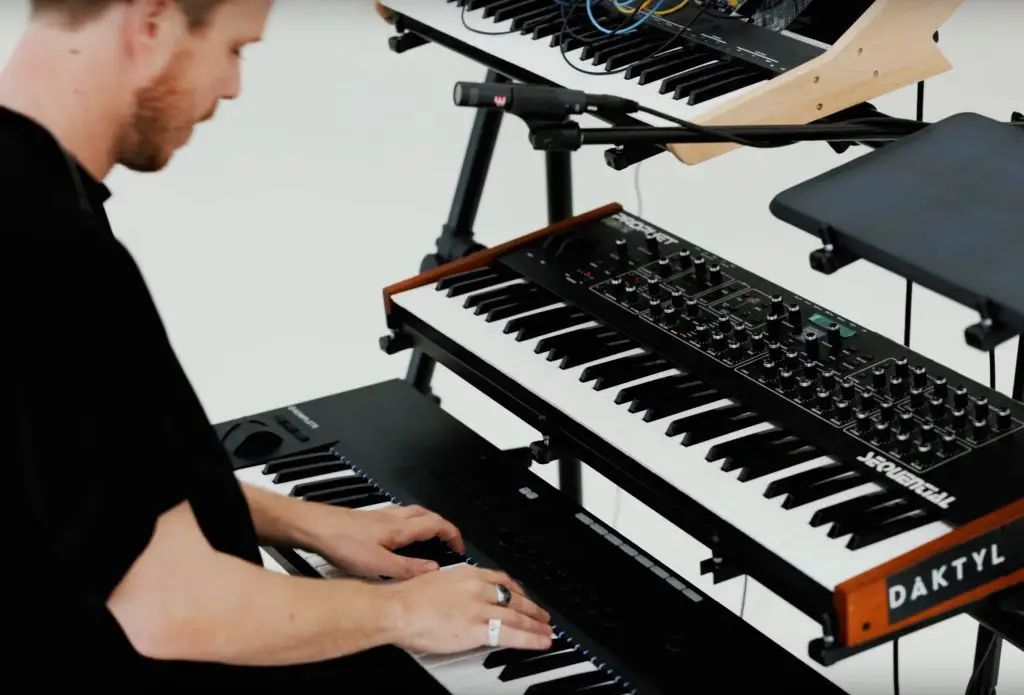Table of Contents
Daktyl has been an artist on my radar for quite some time now, ever since I caught wind that he was touring with the likes of ODESZA, Bonobo, and TroyBoi years ago. Since then, he’s performed at some of the biggest festivals worldwide, collaborated with industry titans like Diplo, and done remixes for Major Lazer, Halsey, and many more. His latest record is out on Bitbird, and it’s an eclectic track that pulls from a variety of inspirations and styles, which is my favorite type of release.
So many artists these days find their lane and just rehash iteration after iteration of essentially the same track. I love it when a producer can flex a broad palette of sounds and inspirations; this EP is a perfect example. I wanted to use this opportunity to invite Daktyl on to talk about how he made the track “Shakti,” which features Anjulie’s vocals and is out now on Bitbird.
As always, listen to the song below to acclimate your ears to the vibes, sounds, textures, and production tricks we’ll discuss in this latest How It’s Made feature before diving into the insights that Dactyl is about to share. So, let’s go.

Prophet Rev 2 by Sequential

The Prophet Rev2 is a polyphonic synthesizer designed by Dave Smith. It’s incredibly versatile, offering a wide range of sounds thanks to its endless modulation options. With up to 16 voices, two oscillators per voice, and a variety of filters and effects, the Rev2 is perfect for both classic and modern sound design.
It has become indispensable to my music-making process, earning its place as the main synthesizer in my home studio. A few years ago, I crafted a patch on this synthesizer that I now frequently use to build chords for my songs. The patch primarily comprises a sawtooth and a square wave, with a touch of white noise. It features very delicate LFOs modulating the pitch, detune, and filter cutoff frequency. It also uses the Rev 2’s unique ‘slop’ parameter that introduces a slight wobbliness and warble, giving the sound a distinctive character.
If you own a hardware synthesizer, building up a library of patches is incredibly useful. I dedicate a certain amount of time each week to sound design sessions, creating new patches for my synths. This routine makes sure that when it’s time to create songs, I have a wide array of bespoke options at my fingertips, allowing me to focus on the music without getting bogged down in the sound design process.
Life by XLN audio

Life by XLN audio allows you to creatively sample things around you and mangle them into random loops and beats. This plugin lets you capture real-world sounds and transform them into unique musical elements. With its intuitive interface and powerful processing capabilities, you can chop, slice, and rearrange samples to create new rhythms and textures.
When creating “Shakti,” I utilized the Life plugin to develop the main rhythmic chord pattern in the verses. To achieve this, I took an entire old demo of one of my songs and fed it into the plugin. By chopping up the demo and experimenting with different segments, I found the inspiration to write over it.
This approach allowed me to breathe new life into an existing piece of music I had lying around, transforming it into a fresh rhythmic foundation for “Shakti.” The Life plugin’s capabilities enabled me to explore new creative possibilities, ultimately shaping the track’s unique sound.
When using this plugin, I recommend experimenting with the sound variation and syncopation buttons until you create a loop that is interesting but not overwhelming. It’s easy to end up with very full and overly complex loops, so scaling back on these parameters can help maintain balance. This approach leaves space in the loop, preventing it from feeling too chaotic
Tape by Softube

Tape by Softube is a tape saturation plugin that allows you to add the sound of vintage analog tape machines to anything within your DAW. It effortlessly recreates the warmth, depth, and character of classic tape recordings, bringing a touch of analog magic to your digital productions. With easy-to-use controls and advanced features like tape speed stability settings, this plugin can enhance any track with authentic tape saturation, from subtle warmth to full-on vintage vibes.
I use this plugin on my drum buss to give my drums a gentle tape saturation, adding warmth and depth. It’s a fantastic plugin for anything that needs a bit of extra warmth.
I also use it on most of my synths. There’s a hidden menu with a speed stability setting that gives a subtle tape warble effect when used lightly, which is my personal favorite. This adds a unique character to my synths, making them stand out. Overall, this plugin is an essential part of my music production, providing a rich, vintage feel to both drums and synths.
Quick Fire Tips For Making Indie Electronic
Tip #1: It took me a long time to realize that taking elements out of a song can be just as powerful as adding them. Now, I aim to create finished songs that convey the intended emotion using the fewest possible elements.
Tip #2: Separate the sound design process from the song creation process.
I’m constantly searching for samples and design sounds. This practice has resulted in terabytes of unique loops and sounds that only I have access to. So, when it’s time to write a song, I have a wide array of sonic delights to choose from, allowing me to focus on writing without getting bogged down in sound design. This is why I view these processes as very separate creative muscles that can work in tandem, but for me are best separated.
Tip #3: Similar to the previous tip, having a set of drums or go-to samples you use in most songs is invaluable. This is especially useful when collaborating or producing for an artist, as a session’s energy can quickly get dragged down if a producer spends hours EQ’ing a kick or choosing the right vocal sample. Try to work as fast as possible and have an organized assortment of sounds to pull from quickly.
The post How It Was Made: Daktyl – Shakti (feat. Anjulie) (bitbird) appeared first on Magnetic Magazine.



